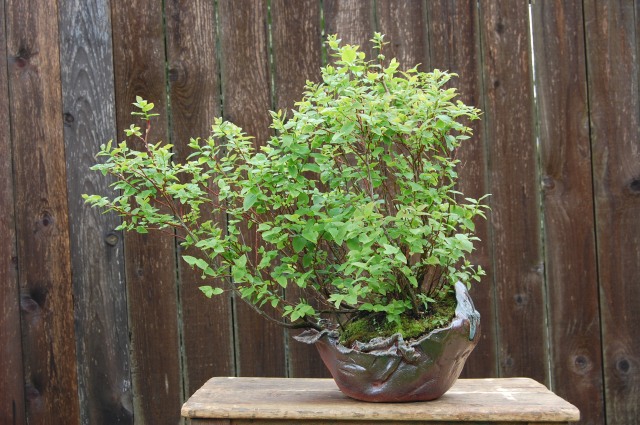This time of year is like a blur to a bonsaiist–everything seems to be going off simultaneously. You can almost feel the energy of the plants and trees we care for, sending out new shoots loaded with leaves and flowers. And while all this is going on, we are trying our best to keep up with the ones that need a new pot or need to have their soil exchanged and roots reduced. It’s about this time I surrender and realize I can’t do it all so I try to get as much accomplished as I can and still leave time to watch them grow and document that here for you on this blog.
The first subject is a Pioneer Gooseberry, Ribes lobbii, in full glory. I posted a close-up of the fruit of this plant in a post titled ‘September Splendor’ and here are the flowers for you. The crimson color is quite something to see in person, I hope the photos can do it justice:
I collected this little shrub in May of 2010 with no idea what the flowers would look like, only that it was in the Ribes tribe. Some closer shots of the flowers:
Another branch of crimson lanterns:
Here’s a Black Huckleberry for you I’ve posted before; it was in a Mardella Brock pot until this beauty from potter Jan Rentenaar found its way to me. It reminds me of a giant huckleberry that burst open:
Some close-ups of the flowers:
There are four flowers, can you see them? They have an interesting form but not much color when fully open. A shot of the light pink color when they first appear:
One more with an insect–looks like an ant to me:
I collected this Winged Elm while living in Missouri, 24 years ago. I planted a Bird’s Foot Violet near the trunk that came from the same area. They are waking up together this year:
Closer:
Another Bird’s Foot Violet in its own Jim Barrett pot:
I should include the Latin name, Viola pedata, and the reason for birds and feet being dragged into this 😉 The leaves of the plant resemble the toes of a bird spread out. Hard to believe I’ve kept this alive for 24 years, but I collected it in 1989! The next offering is an Arizona Alder I’ve had for nine years now:
It’s at its best just now as the leaves become larger with the warmer weather. It can be partially defoliated as the season rolls along and the newer set of leaves do come in smaller. Its winter silhouette is getting nicer as the twigs slowly ramify. It really likes the climate here in the Pacific Northwest, some 1,600 miles further north in latitude to where it’s native. Coming up is a Pignut Hickory I’ve had for 24 years, also collected in Missouri:
This is one of those trees that is difficult to get to ramify, so I’ve pretty much left it alone and keep it for curiousity’s sake. A close shot of the plated bark is a nice feature of this tree:
And the nebari (Japanese for surface root) is of interest as well:
I always like to end a visual feast with a little ‘eye candy’ and an unusual subject at that. Here is a little plant that has evolved to live off another host and only puts up a flower–Orobanche uniflora var. purpurea or more commonly known as Naked Broomrape:
It’s the tiny purple flower with the yellow tongue in the center of the photo. A side view of the same flower:
It popped up amid some Prairie Stars, Lithophragma parviflora, I think may be the host plant. But there are also lots of grasses that could be hosts as well. It’s been open for a few days now, a nice surprise that was unanticipated. That’s all folks, thanks for stopping by for another look!

















